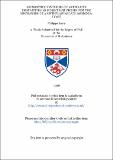Asymmetric synthesis of amino acid derivatives as molecular probes for the mechanism of 3-methylaspsartate ammonia-lyase
Abstract
3-Methylaspartate ammonia-lyase is a bacterial enzyme that catalyses the reversible elimination of ammonia, in the presence of monovalent and divalent metal ions, from (2S,3S)-3-methylaspartic acid to yield mesaconic acid. The catalytic mechanism of the wild type enzyme obtained from Clostridium tetanomorphum involves a concerted elimination of ammonia and is thought to operate via the intermediacy of a dehydroalanine residue at the active site. No direct evidence has been established so far concerning the existence of this dehydroalanine residue, except that 3-methylaspartate ammonia-lyase was found to be irreversibly inactivated by phenylhydrazine. Inactivation of the enzyme with labelled ¹⁵Nβ-phenylhydrazine and subsequent ¹⁵N-edited NMR spectra of the digested enzyme resulted in a proposal for the inhibition mechanism by phenylhydrazine. This mechanism involved the conjugate addition of phenylhydrazine onto the dehydroalanine moiety and the subsequent cyclisation to give a cyclic adduct. A synthetic model containing a ¹⁵N atom of this adduct was synthesised and the NMR data obtained were compared with the spectra obtained earlier from the enzyme experiment. In order to carry out mapping studies of the active site it was highly desirable to prepare molecules capable of reacting specifically and irreversibly at the active site. To this end, the synthesis of aminofumaric acid and (2S,3S)-3-methyl N-amino aziridine dicarboxylic acid were attempted. (2S,3R) and (2R,3R)-3-Methylsuccinic acids were prepared in 5 steps from (2S,3S)-3-methyl aspartic acid. These compounds were found to behave as noncompetitive inhibitors of β-methylaspartase. (2S)-3,3-Dimethylaspartic acid was also synthesised and found to be a competitive inhibitor having the same binding affinity as the natural substrate. In order to prepare a β-electrophilic amino acid analogue of the physiological substrate, an asymmetric synthesis was designed that involved the stereoselective alkylation and acylation of suitably protected (2S,3S)-3-methylaspartic acid. The stereochemistry of the reaction was established via the X-ray structure of the camphanic derivative resulting from the alkylation of protected (2S,3S)-3-methylaspartic acid with chloroiodomethane. The X-ray structure of an acylated adduct was also determined. This method allowed diastereoselective synthesis of a highly functionalised amino acid, (2S,3S)-3-formyl-3-methylaspartic acid, in 7 steps which was found to be a powerful competitive inhibitor (Ki = 0.57 µM). The inhibitory properties could be explained via the interaction of the cyclic furanyl form of the aldehyde. In addition, this synthesis also proved to be useful in the synthesis of a stable protected trans-(2S,3S)-3-methylazetidine 1,2-dicarboxylate diester for which a X-ray structure was determined.
Type
Thesis, PhD Doctor of Philosophy
Collections
Items in the St Andrews Research Repository are protected by copyright, with all rights reserved, unless otherwise indicated.

